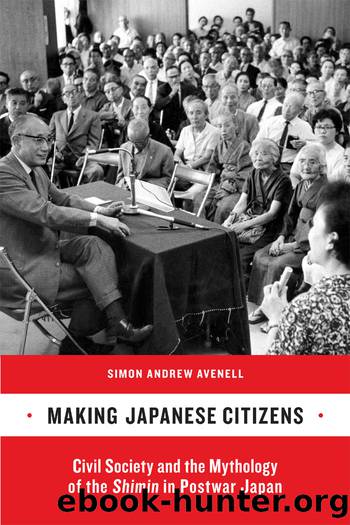Making Japanese Citizens by Simon Andrew Avenell

Author:Simon Andrew Avenell
Language: eng
Format: epub
ISBN: 9780520947672
Publisher: University of California Press
Published: 2010-08-15T00:00:00+00:00
THE DISCOURSE ON CITIZEN PARTICIPATION: THEORIZING SHIMIN SANKA
If 1964 was a revolutionary year for local activism in Japan, then 1963 was arguably an epoch-making one for local government. In the nationwide local elections of 1963, progressive administrations came to power in Yokohama, Kyoto, Osaka, and Kita-Kyushu, as well as many other small- and medium-sized administrative areas, such as Asahikawa, Kushiro, Tochigi (City), Ueda, and Niihama.140 The icing on the cake came in 1967, when the âsmilingâ statistician Minobe RyÅkichi was elected governor of Tokyo. The progressive onslaught continued into the 1970s: after the local elections of 1971, progressives controlled one-third of the nationâs local governments,141 and by 1975, 10 of the 47 governorships and 20 percent of the 642 mayoral positions nation-wide were in the hands of progressives.142 At least two factors were behind this political realignment at the local level. First, it was clearly a reflection of widespread discontent with the less-palatable aspects of high-speed growth, such as pollution and urban overcrowding. Second, progressives also helped themselves with shrewdly crafted promises of citizen politics based on institutional reform, direct citizen participation, and the setting of civil minimums.
Matsushita Keiichi, Narumi Masayasu, and others in the Tosei ChÅsakai were quick to mobilize after the progressive electoral landslide of 1963. Apart from Matsushita, who preferred to contribute from the safety of the academy, members of the Tosei ChÅsakai fanned out as advisers and officials in the new administrations. In Yokohama, Narumi Masayasu took on the position of policymaking bureau chief for Mayor Asukata, writing the mayorâs speeches, formulating his civic policies, and, more generally, transforming Asukataâs image from far-left JSP dietman to progressive champion of the ordinary citizen.143 Narumi skillfully refashioned Asukataâs public image, injecting a shimin flavor into almost everything the mayor said or did. As Michiba Chikanobu explains, at the outset Asukata and Narumi were ideological oil and water. Steeped in socialist revolutionary dogma, the progressive mayor was initially opposed to the idea of incremental structural reform, and, as Narumi put it, he was an âold Bolshevikâ whose penchant for ideology was in serious need of control. Conversely, Asukata viewed his citizen faction adviser as a matter-of-fact âWeberianâ and a rational supporter of systemic reform. As Asukata quipped, the resulting policy was one of âMarx dressed up as Weber,â although the mayor undeniably conceded more ideologically than his adviser.144 Narumi was joined in the Yokohama administration by fellow Tosei ChÅsakai member Tamura Akira, who acted as chief engineer in the Planning and Coordination Bureau. In Sendai City, the Tosei ChÅsakaiâs Sugiwara Yoshihisa joined the progressive Shimano administration as a special secretary (tokubetsu hisho), in the same capacity that Yasue RyÅsuke joined Minobe RyÅkichiâs Tokyo governorship in 1967.
From such strongholds, the Tosei ChÅsakai group set about making local democracy and local government reform a reality. But the excitement of a progressive future would not last long, because, as we have seen, almost immediately the shiny new administrations came face to face with the reality of local protest and the institutionalized conservatism and corruption of local politics.
Download
This site does not store any files on its server. We only index and link to content provided by other sites. Please contact the content providers to delete copyright contents if any and email us, we'll remove relevant links or contents immediately.
| Central Asia | Southeast Asia |
| China | Hong Kong |
| India | Japan |
| Korea | Pakistan |
| Philippines | Russia |
The Rape of Nanking by Iris Chang(3537)
The Sympathizer by Viet Thanh Nguyen(3534)
World without end by Ken Follett(3017)
Ants Among Elephants by Sujatha Gidla(2933)
Blood and Sand by Alex Von Tunzelmann(2617)
Japanese Design by Patricia J. Graham(2569)
City of Djinns: a year in Delhi by William Dalrymple(2142)
Inglorious Empire by Shashi Tharoor(2109)
In Order to Live: A North Korean Girl's Journey to Freedom by Yeonmi Park(2066)
Foreign Devils on the Silk Road: The Search for the Lost Treasures of Central Asia by Peter Hopkirk(2064)
Tokyo by Rob Goss(2025)
India's Ancient Past by R.S. Sharma(1994)
India's biggest cover-up by Dhar Anuj(1993)
The Great Game: On Secret Service in High Asia by Peter Hopkirk(1967)
Tokyo Geek's Guide: Manga, Anime, Gaming, Cosplay, Toys, Idols & More - The Ultimate Guide to Japan's Otaku Culture by Simone Gianni(1954)
Goodbye Madame Butterfly(1942)
The Queen of Nothing by Holly Black(1773)
Living Silence in Burma by Christina Fink(1739)
Batik by Rudolf Smend(1728)
